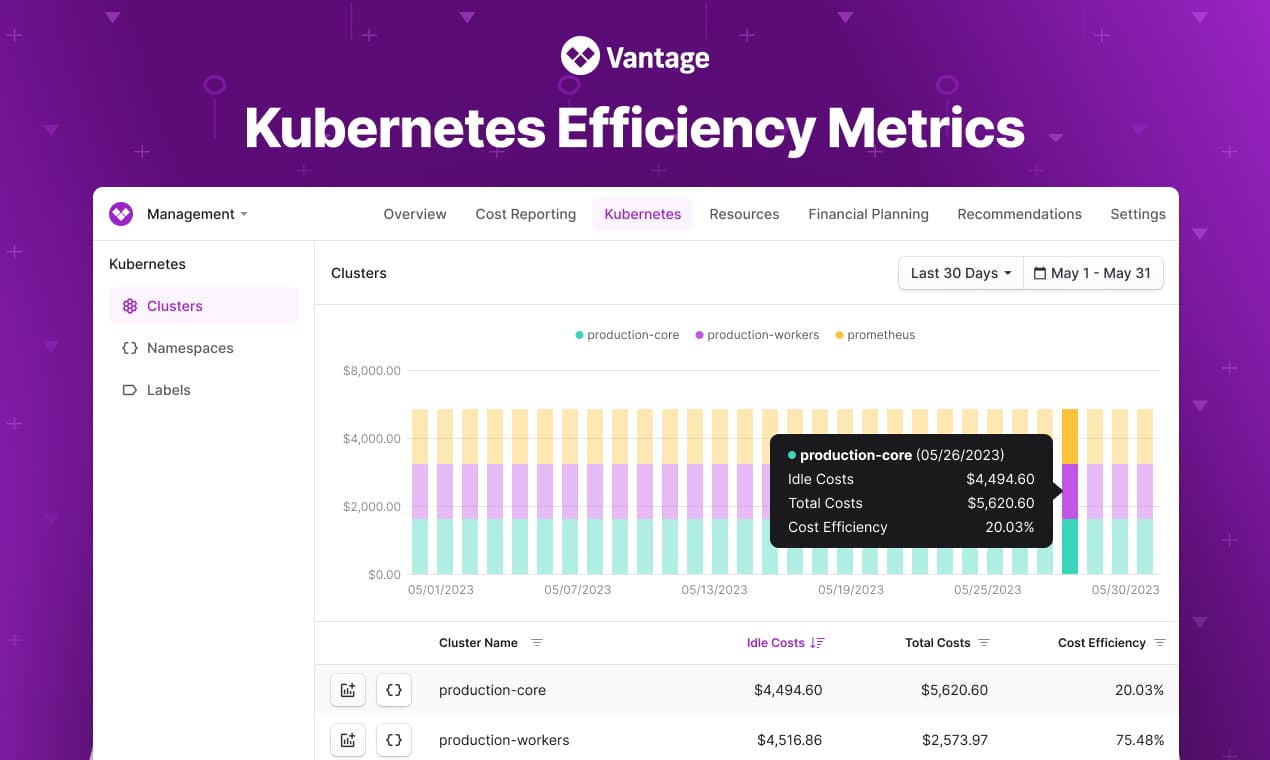Vantage Launches Kubernetes Cost Efficiency Metrics
Manage the efficiency of your Kubernetes clusters in addition to enterprise reporting, visibility, and cost allocation.

Today, Vantage announces the launch of Kubernetes Cost Efficiency Metrics. Customers can now view how efficiently their Kubernetes clusters, namespaces, and labels are provisioned on a day-by-day basis. This allows businesses to manage the efficiency of their Kubernetes clusters in addition to existing enterprise reporting, visibility, and cost allocation features already present on Vantage for both in-cluster and out-of-cluster costs.
Vantage already offers best-in-class Kubernetes cost reporting and cost allocation features for customers who have integrated with OpenCost. Despite this, understanding efficiency and taking measures to optimize underlying clusters was not possible in Vantage. Given Kubernetes can oftentimes represent the overwhelming majority of a company’s entire cloud bill, providing developers the tools they need to view Kubernetes efficiency metrics is increasingly becoming a necessity. This previously meant that Vantage customers were using multiple FinOps tools or manually managing this workflow in-house, which was expensive and cumbersome.
Now, there is a new Kubernetes portion of the Vantage console, initially devoted to viewing Kubernetes costs and efficiency metrics. Customers who have not yet connected OpenCost will be given copy-and-paste instructions for getting up and running with OpenCost and provisioning a managed Prometheus-compatible endpoint. For existing or newly connecting OpenCost users, customers can now view connected clusters’ namespaces and labels with the following information:
- Name: The name of the cluster, namespace of label you’re viewing.
- Idle Cost: A dollar value representation of the amount of resources requested that are idle.
- Total Cost: A dollar value representation of the total cost of resources.
- Cost Efficiency %: The ratio of idle costs and total costs.
Using these views, users can effectively judge how well-provisioned their Kubernetes resources are and identify the deployed applications that are over-provisioned. In the future, Vantage will also give recommendations for rightsizing Pods accordingly.
This feature is now available for all users. If you already have an OpenCost integration, you can follow the upgrade instructions and then view your efficiency metrics on the Kubernetes page within 24 hours. If you want to create an OpenCost integration you can visit the integrations page to get started.
Frequently Asked Questions
1. What is being launched today?
Today, Vantage is launching Kubernetes cost efficiency metrics for Kubernetes clusters integrated with OpenCost. Users can see efficiency metrics for each configured cluster.
2. Who is the customer?
The customer is any Vantage user who has Kubernetes clusters deployed that have integrated with OpenCost.
3. How much does this cost?
Kubernetes efficiency metrics are available at no additional cost for customers in Starter, Pro, and Business tiers. For customers in our Enterprise tier, please contact sales to get a quote.
4. What are efficiency metrics?
Pod resource efficiency is defined as the resource utilization versus the resource request over a given time window. These resource utilization metrics include CPU and RAM. When viewing efficiency it will be shown as a percentage. 100% means the resource allocation is fully efficient.
5. If I have a CloudWatch Container Insights integration configured, can I see efficiency metrics?
No, however we recommend migrating over to an OpenCost integration. Vantage is in the process of deprecating support for CloudWatch Container Insights as it's more expensive and limited in its ability to effectively provide a best-in-class cost solution for Kubernetes. You can contact support@vantage.sh for assistance in changing your integration.
6. What is OpenCost?
OpenCost is a vendor-neutral open source project for measuring and allocating infrastructure and container costs in real time. The OpenCost Integration can be enabled for both managed Kubernetes environments (EKS/GKE) and self-managed Kubernetes environments.
7. How long does it take for efficiency metrics to be displayed in the UI?
Efficiency metrics are available immediately after your OpenCost metrics are imported, generally once per day.
8. How do I set up an OpenCost integration?
Deploying an OpenCost integration involves installing OpenCost on your cluster as well as deploying a Managed Prometheus Workspace in order for Vantage to access the metrics. You can read our docs in order to get started.
9. What are Idle Costs and how are they calculated?
Idle costs are defined as the difference between the cost of requested resources (CPU and Memory) and the associated usage of those costs.
10. What are the recommended efficiency metrics for my clusters?
This will depend heavily on your specific workload. As an example, a worker process that has jobs ranging from low to high memory usage might have a relatively low efficiency due to its need to have access to more memory for some jobs. In contrast, a static website with predictable memory and CPU utilization might instead have a relatively high efficiency.
11. What version of OpenCost is required for efficiency metric support?
While we work to upstream this work, users will need to temporarily deploy the Vantage-maintained OpenCost branch at quay.io/vantage-sh/opencost:efficiency.
12. What are the different ways I can view efficiency metrics?
When viewing efficiency metrics for a cluster you can filter them in a couple of different ways:
- Change the date range to see how they have changed over time.
- Change the aggregation to see the metrics by cluster, namespace, and label.
13. Can I see the efficiency of a provisioned storage volume?
No, unfortunately, we do not have access to see how much of the volume is used.
14. I just deployed OpenCost on my cluster, how do I know if Vantage is successfully receiving pod efficiency metrics?
Efficiency metrics will be available up to 24 hours after updating your clusters. You can query the Amazon Managed Prometheus associated with your integration for count(container_cpu_idle) by (cluster_id) to verify the metrics are making it from your Kubernetes cluster to the Prometheus that Vantage will use to gather them periodically.
15. Is there devoted documentation where I can learn more about Vantage's integration with Kubernetes clusters?
Yes, head over to our Kubernetes-specific documentation here.
Sign up for a free trial.
Get started with tracking your cloud costs.

